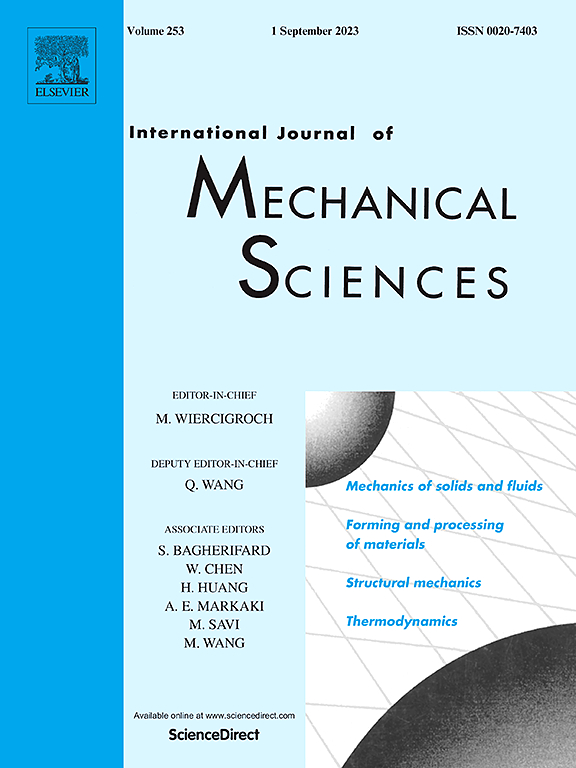Observation of multi-type corner states in right-angled trapezoidal sonic crystals
IF 7.1
1区 工程技术
Q1 ENGINEERING, MECHANICAL
International Journal of Mechanical Sciences
Pub Date : 2025-03-27
DOI:10.1016/j.ijmecsci.2025.110144
引用次数: 0
Abstract
Previous research has demonstrated corner states with various angular types through distinct structural configurations. However, achieving multiple corner state types within a single lattice has remained elusive. This study addresses the challenge in realizing multi-type corner states within a unified lattice design by introducing a novel right-angled trapezoidal topological sonic crystal. We propose a two-dimensional C-shaped square-lattice unit cell with symmetry, which facilitates the realization of topological quadrupoles without relying on tight-binding mechanisms. The topological properties within the quadrupole topological band gap are confirmed through Wannier band and nested Wannier band calculations, with the location of Wannier centers accurately predicting the distribution of edge and corner states. To illustrate this, we construct both square-shaped and right-angled trapezoidal sonic crystals with a unified lattice design. Unlike the square-shaped structure, the trapezoidal design supports multi-type corner states at distinct frequencies, accommodating obtuse, right, and acute angles. An additional in-gap hypotenuse edge state underscores the versatility of this design. Experimental results validate these theoretical predictions, offering concrete evidence of multi-type corner states and their unique behaviors. This innovative approach not only simplifies the realization of topological quadrupoles but also opens new avenues for applications in acoustic wave control, energy harvesting, and precise sound manipulation.

直角梯形声波晶体中多类型角态的观察
以往的研究已经通过不同的结构形式证明了角态的不同角度类型。然而,在单个晶格中实现多个角态类型仍然是难以捉摸的。本研究通过引入一种新颖的直角梯形拓扑声晶体,解决了在统一晶格设计中实现多类型角态的挑战。我们提出了一种具有p4gg对称性的二维c形方晶格单元胞,这有助于在不依赖紧结合机制的情况下实现拓扑四极体。通过万尼尔带和嵌套万尼尔带计算,确定了四极拓扑带隙内的拓扑性质,并利用万尼尔中心的位置准确预测了边缘和角态的分布。为了说明这一点,我们用统一的晶格设计构造了方形和直角梯形声波晶体。与方形结构不同,梯形设计支持不同频率的多种转角状态,可容纳钝角、直角和锐角。一个额外的间隙内斜边状态强调了这种设计的多功能性。实验结果验证了这些理论预测,提供了多类型角态及其独特行为的具体证据。这种创新的方法不仅简化了拓扑四极杆的实现,而且为声波控制、能量收集和精确声音操纵的应用开辟了新的途径。
本文章由计算机程序翻译,如有差异,请以英文原文为准。
求助全文
约1分钟内获得全文
求助全文
来源期刊

International Journal of Mechanical Sciences
工程技术-工程:机械
CiteScore
12.80
自引率
17.80%
发文量
769
审稿时长
19 days
期刊介绍:
The International Journal of Mechanical Sciences (IJMS) serves as a global platform for the publication and dissemination of original research that contributes to a deeper scientific understanding of the fundamental disciplines within mechanical, civil, and material engineering.
The primary focus of IJMS is to showcase innovative and ground-breaking work that utilizes analytical and computational modeling techniques, such as Finite Element Method (FEM), Boundary Element Method (BEM), and mesh-free methods, among others. These modeling methods are applied to diverse fields including rigid-body mechanics (e.g., dynamics, vibration, stability), structural mechanics, metal forming, advanced materials (e.g., metals, composites, cellular, smart) behavior and applications, impact mechanics, strain localization, and other nonlinear effects (e.g., large deflections, plasticity, fracture).
Additionally, IJMS covers the realms of fluid mechanics (both external and internal flows), tribology, thermodynamics, and materials processing. These subjects collectively form the core of the journal's content.
In summary, IJMS provides a prestigious platform for researchers to present their original contributions, shedding light on analytical and computational modeling methods in various areas of mechanical engineering, as well as exploring the behavior and application of advanced materials, fluid mechanics, thermodynamics, and materials processing.
 求助内容:
求助内容: 应助结果提醒方式:
应助结果提醒方式:


